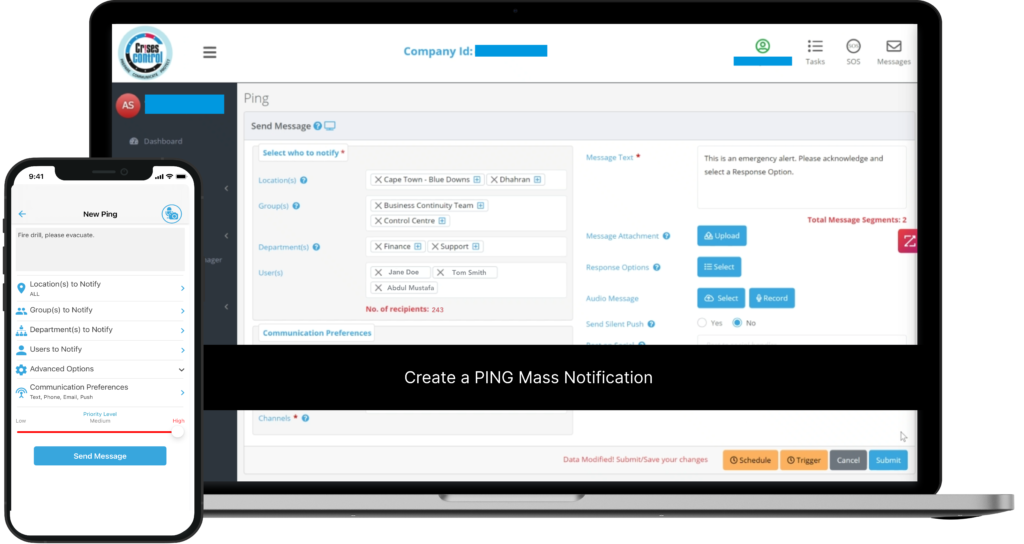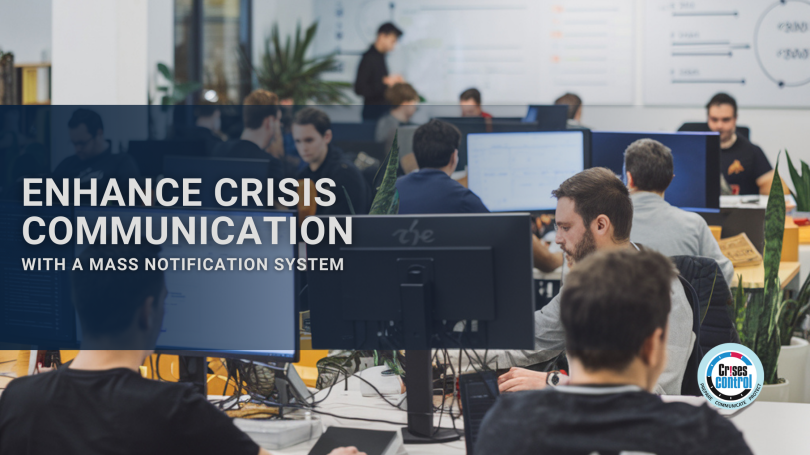Written by Ikram Tassi | Marketing
Crisis situations can arise at any moment, without warning. Whether it’s a natural disaster, a security breach, or a workplace accident, the effectiveness of your communication during these times can make all the difference. A well-executed crisis communication plan isn’t just about having a solid response protocol; it’s about ensuring that information flows quickly, clearly, and accurately to the right people. This is where Mass Notification Systems come in.
A Mass Notification System is a powerful tool that allows businesses to instantly reach large groups of people during emergencies. But, integrating this system with your existing Crisis Management Software and Emergency Response Communication Solutions can elevate your crisis preparedness. In this blog, we’ll explore why mass notification systems are essential, how they improve crisis management, and how Crises Control can help you streamline your response and enhance safety when it matters most.
What Is a Mass Notification System?
A Mass Notification System (MNS) is a communication tool that allows organisations to send emergency alerts and important messages to a large group of people quickly. These systems are designed to help organisations stay in control of the situation by keeping employees, customers, and stakeholders informed during critical moments.
MNS can deliver alerts through multiple communication channels such as:
- Text messages (SMS)
- Emails
- Voice calls
- Mobile app notifications
- Social media posts
The primary goal is to make sure everyone affected by a crisis knows what’s happening, what to do, and how to stay safe. By reaching the right people in real-time, an MNS can help reduce confusion, speed up decision-making, and even save lives.
Why Mass Notification Systems Are Critical for Crisis Management
When a crisis strikes, the first few moments are crucial. The speed and clarity of communication can determine whether the response is successful or whether the damage is minimised. Here’s why Mass Notification Systems play such a pivotal role in crisis management:
1. Speed and Timeliness: The Power of Real-Time Communication
During a crisis, time is always a factor. The longer it takes to communicate, the more chaotic the situation can become. With traditional communication methods—such as calling individual team members or sending emails—there’s a high risk of delays. Mass Notification Systems eliminate this issue by sending automated alerts to everyone at once.
Whether it’s a fire, security threat, or system outage, your employees and stakeholders will know what’s happening instantly. With automated alerts, you don’t have to worry about human error or bottlenecks, and you can focus on managing the crisis itself.
2. Clear, Concise, and Targeted Communication
Effective communication isn’t just about sending any message; it’s about sending the right message to the right people. During a crisis, confusion can cause major disruptions. A good MNS ensures your message is clear, concise, and specific to the recipient.
For example, if there’s a fire in one part of the building, only the people in that area should be notified with instructions to evacuate. A well-structured Mass Notification System can send messages based on location, department, or role—tailoring the message to the recipient’s needs.
3. Multi-Channel Communication: Reaching People Everywhere
Not everyone will have access to the same communication channel in a crisis. Some employees may be near their phones, while others may be away from their desks. A robust Mass Notification System ensures that your message reaches everyone, no matter what channel they prefer or are using at the time.
Crises Control’s Emergency Response Communication Solutions allow you to send messages via multiple channels, including SMS, email, voice calls, push notifications, and even social media, ensuring no one misses important information, whether they’re at their desk, at home, or on the move.
How Integrating Mass Notification Systems With Emergency Response Protocols Enhances Crisis Management
While a Mass Notification System is a vital tool for crisis communication, its true value lies in its integration with your emergency response protocols. Emergency response protocols are pre-established action plans designed to help organisations respond effectively when a crisis occurs. Here’s how integration helps:
1. Streamlined Communication Across Departments
Crisis management often involves several departments—security, IT, HR, facilities management, and leadership teams. Without proper integration, these teams may struggle to coordinate and share critical information in real-time. By integrating your Mass Notification System with your existing protocols, you can ensure that all relevant parties are notified automatically and promptly.
For example, if a security threat is detected, the system can immediately notify the security team, management, and any employees in the affected area. Everyone knows their role and what actions to take, eliminating confusion and delays.
2. Automated Alerts and Triggers
One of the key benefits of integration is that it allows for automated alerts. These alerts are triggered based on specific actions or events, such as the activation of a fire alarm, an intruder alert, or the detection of a cybersecurity breach.
For example, when a flood warning is issued, your system could automatically trigger an alert that provides instructions on evacuation routes, safety tips, and even information on how to secure critical systems remotely. The more automated the process, the faster and more effectively your team can respond.
3. Real-Time Updates and Adaptation
Emergencies evolve rapidly. What starts as a fire alarm might turn into a larger evacuation situation, or a security breach may quickly escalate. By integrating Mass Notification Systems with your emergency protocols, your team can receive real-time updates, allowing them to adapt and act accordingly.
Crises Control’s Crisis Management Software provides live status updates, so you can monitor the ongoing situation and keep your team informed as circumstances change.
How Crises Control Helps Integrate Mass Notification Systems With Crisis Protocols
Crises Control is built with flexibility and ease of use in mind, offering comprehensive solutions to improve communication, streamline crisis management, and ensure employee safety. Here’s how Crises Control can enhance your crisis response efforts:
1. Seamless Integration With Existing Systems
Crises Control easily integrates with your existing Crisis Management Software and protocols, ensuring that your organisation can automatically trigger alerts based on specific scenarios. Whether it’s a fire, power outage, or cybersecurity breach, Crises Control can automate the alert process and integrate seamlessly with your crisis management tools.
2. Multi-Channel Alerts Across Devices
Whether your team is at their desk, working remotely, or on the go, Crises Control’s Mass Notification System ensures that all employees are reached instantly across multiple channels, including SMS, email, voice calls, push notification. Even in high-stress situations, your message will reach its target without fail.
3. Customisable Alerts for Different Teams
Every crisis is unique, and so are the teams involved. Crises Control allows businesses to customise their alerts based on the specific needs of different teams or locations. For example, the security team may receive one type of message, while HR may receive another. This targeted communication ensures that everyone is informed in a timely and relevant manner.
4. Real-Time Monitoring and Reporting
Real-time updates are crucial during a crisis. With Crises Control, crisis managers can monitor the status of the response, check who has received the message, and track the effectiveness of the alert system. If any part of the plan isn’t working as expected, adjustments can be made immediately.
Interested in our Ping Mass Notification System?
Efficiently alert everyone in seconds at scale with our Mass Notification System – PING, get the message out fast and ensure rapid response and recovery.

The Benefits of Mass Notification Systems in Crisis Management
By integrating a Mass Notification System into your crisis management plan, you can enjoy a range of benefits that improve efficiency and enhance safety during a crisis:
1. Faster Response Times
- Automated alerts ensure that your team responds faster, minimising the impact of the crisis.
2. Improved Coordination
- Integrated systems ensure that all teams are on the same page and working together efficiently.
3. Reduced Downtime
- Quick, coordinated action means your business can return to normal operations more quickly after the crisis is resolved.
4. Enhanced Employee Safety
- Clear communication during emergencies helps ensure that employees know exactly what to do to stay safe.
The Importance of Regular Drills and Testing
Even the best systems need to be tested. Regular drills and testing are essential to ensure that everyone knows how to use the Mass Notification System and that your emergency protocols are effective. Crises Control offers simulation features that allow you to practice crisis scenarios, ensuring that your team is prepared for any situation.
Conclusion: Take Control of Your Crisis Communication Today
Effective crisis management requires more than just a plan; it requires fast, clear, and coordinated communication. By integrating a Mass Notification System like Crises Control with your emergency response protocols, you can ensure that your team is always prepared to respond quickly and effectively when disaster strikes.
Ready to enhance your crisis communication? Don’t wait for the next emergency to expose weaknesses in your system. Contact us today to schedule a free demo and see how our platform can help your organisation improve its crisis response and communication strategies.
Request a FREE Demo

